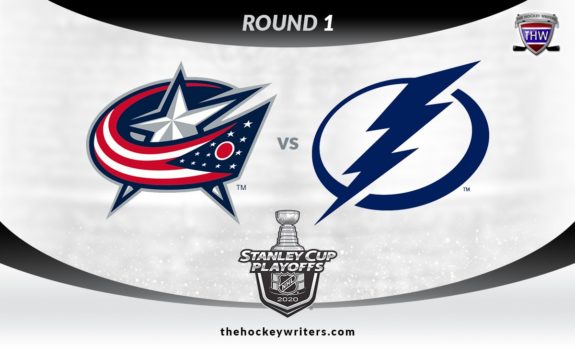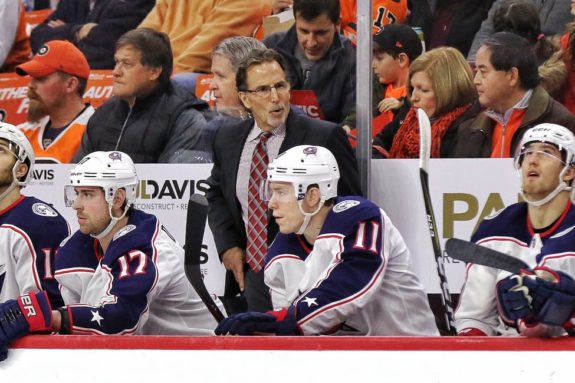It’s now an uphill battle for the Columbus Blue Jackets after losing Game 3 by a score of 3-2 to the Tampa Bay Lightning. In this best-of-seven series, it takes four wins. And they now need three wins with only four games remaining. A lack of production from the power play was a key factor. An extended 5-on-3 in the first period came up empty (as did all four of the Columbus power plays).

Columbus is now 2-for-12 on the power play this series (under 17 percent) and 2-for-26 in the postseason (under eight percent). In the regular season, the Blue Jackets were one of the league’s worst power-play teams, recording a miserable 16.4 percent. (Even one power-play goal in Game 3 of this series would not have brought Columbus up to that level for the postseason.)
Missing Pieces and Mixed Messages
Like Game 2, Columbus coach John Tortorella was missing a few key players, including forwards Cam Atkinson and Nathan Gerbe (both unfit to play), as well as Josh Anderson (who has yet to appear in the postseason) and goalie Elvis Merzlikins (unfit to play).
Related: Blue Jackets Inconsistent Power Play Finally Powering Up
Prior to Game 3, a couple of Lightning players, including Patrick Maroon, said their team needs to be more physical around the Blue Jackets goal. Blake Coleman even said the forwards need to be “a little more violent.” (from ‘Pat Maroon: Lightning ‘need to be better’ at net front,’ Tampa Bay Times, 08/15/2020) Maroon and Coleman were both penalized in the first period. In Game 1, Lightning forward Yanni Gourde drew blood with a sucker punch to David Savard. In Game 2, Alex Killorn gave Blue Jacket defenseman Seth Jones a solid punch to the head. With Game 3’s early calls, the officials seemed to want to send a message to Tampa Bay’s bench.
By the Numbers
I know it’s hard to believe, but Seth Jones did not lead the Blue Jackets in time on ice. His 26:11 TOI was more than a full minute less than defensive partner Zach Werenski’s 27:21. Blue Jackets Oliver Bjorkstrand was the only forward to break the 20-minute mark for either team.

Despite taking the loss, Columbus goalie Joonas Korpisalo’s .912 save percentage (31 of 34) was substantially better than the Lightning’s Andrei Vasilevskiy’s .882 (15 of only 17 shots on goal). Jones was the only Blue Jacket with more than two shots on goal (four), while the Lightning had five players record three or more shots, led by defenseman Ryan McDonagh’s six.
Related: Lightning That Got Away: Seth Jones
The Blue Jackets penalty kill, which was stellar in the first two games of the series (6-for-6) against the high-flying Lightning, faced only one minor penalty. They blocked all three shot attempts by the Lightning on that second-period power play. (Columbus was credited with 24 blocked shots for the game, versus only nine for Tampa Bay.)
The Blue Jackets had “home-ice advantage” for Game 3, which regular readers know I think can be an important advantage, especially when it comes to line matchups and faceoffs. But let’s take a closer look at faceoffs for the Blue Jackets in this postseason. In both this series and the Qualifying Round, the key faceoff men for Columbus have consistently been Boone Jenner, Pierre-Luc Dubois, and Riley Nash.

The Lighting rely primarily on centers Braydon Point and Anthony Cirelli, although left-wing Gourde sees the dot regularly. Gourde’s faceoff appearances in the first two games of the series often came after a centerman has been tossed from the circle. In Game 3, he started the game at center.
Related: NHL Centres Say New Faceoff Rule Should Help Scoring
In the Qualification Round, the Toronto Maple Leafs typically relied on faceoff aces John Tavares and Auston Matthews. During the regular season, both ranked in the league’s top-20, with faceoff win percentages of 55 percent or better. (Jenner tied for 16th at 55.1 percent, Dubois squeaked into the top 100 at 96 with a win percentage of only 44.6 percent.)
Tampa Bay’s top faceoff man, Steven Stamkos (54.3 percent) has yet to make an appearance in the series. Point and Cedric Paquette both topped 50 percent in the regular season, and Gourde, who took only 170 faceoffs during the regular season, won 54.1 percent.

So far in this postseason, the numbers did not support me in the Qualifying Round. The home team won the faceoff battle in three of five games (and it was pretty close in the other two games). However, the team that won more faceoffs lost each game. (What? Can we please just chalk that up to it being a really weird series?)
The first round of the actual 2020 Stanley Cup Playoffs was running truer to form. Tampa Bay had home-ice advantage for Games 1 and 2, and won 51.3 percent of faceoffs in those games. They performed slightly worse in the circle in Game 2 – and lost that game. In Saturday’s Game 3, with Columbus having home ice, the Blue Jackets won 54 percent of the faceoffs, yet lost the game. (In fact, the Lightning’s second goal can be directly attributed to a faceoff win by Point, who then scored the goal.)
[table id=359 /]
Not to say “I told you so,” but the Blue Jackets’ first goal was set up by Gus Nyquist on a takeaway followed by a beautiful pass to send Riley Nash in all alone on Vasilevskiy. A minute-and-a-half later, he drew a penalty, sending Lightning star defenseman Victor Hedman to the box on a hooking call. Nyquist was on the ice for the last shift of the second period with the Lightning leading 3-1. The Blue Jackets’ second goal came just after Nyquist went to the bench to bring on goal-scorer Eric Robinson. (Depending on which scoresheet you read, Nyquist had either one or two assists in the game.) Tortorella’s faith in Nyquist continues to pay dividends.

Devin Shore was the only Blue Jacket to see fewer than 10 minutes of ice time in Game 3. His 7:12 TOI was more than three minutes fewer than the next least-active skater (Dean Kukan, 10:21) and next least-active forward (Eric Robinson, 10:26). Despite Shore’s lack of ice time, the Blue Jackets’ fourth line played substantially more than in prior games of this series. (With the five-plus periods of overtime in Game 1, the comparison isn’t quite apples-and-oranges, but it still works out to about six-and-a-half minutes per 60 minutes of game time.)
Coming Up Next
Game 4 in the series is scheduled for Monday. In the afternoon. Again. 3:00 P.M. EST. Again. (What is with these schedulers? Are there not enough TV viewers to justify putting more games of this series at times when people can actually watch. I mean “watch” without getting in trouble at work.) On the bright side – I guess afternoon games are usually “bright” when compared to night games – the Blue Jackets will again have home-ice advantage.

In Game 4, Tortorella has last line change after whistles. He’ll again be able to choose which skaters to send out after he sees who hits the ice for the Lightning. And then there’s the faceoff advantage, too. Maybe.